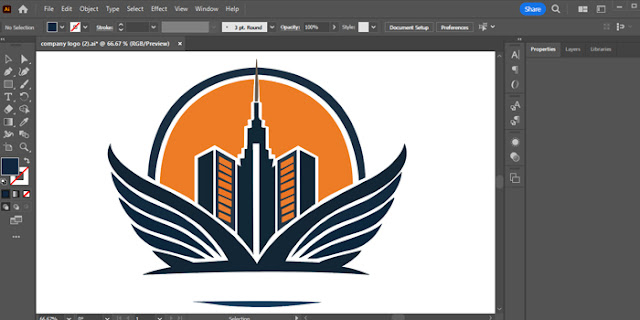Do you know how your logo is supposed to represent everything your brand stands for? It’s like your business’s first handshake. But here’s the problem: what looks great on your website can sometimes turn into a blurry mess when printed on a banner, t-shirt, cap, or jacket. Frustrating, isn’t it? The issue isn’t with your design but the format it’s in. Raster files, like JPEGs or PNGs, don’t scale well. Vector files, however, are your emblem’s secret weapon. They keep your logo sharp, clear, and professional—no matter how big or small. Want to know how it works and why it matters? Stick around, and we’ll show you why logo vectorization is essential for flawless printing.
Achieving Print Excellence Through Logo Vectorization
Bitmap logos are a real challenge. Scalability is a nightmare—your brand mark might look sharp on a business card but turn blurry when enlarged for a t-shirt. On top of that, the colors you see on your screen may not print accurately. Large file sizes and the difficulty in editing bitmap logos add to the frustration. Updating an old design on a tight schedule? It’s like hitting one roadblock after another.
The Advantages of Vectorized Logos in Print Materials
A) Strong Visual Representation
Even in a digital world, a printed logo is the face of your
brand. Unlike raster images, which blur when stretched or compressed,
vectorized logos stay sharp at any size. Whether your logo is on a mug, a
t-shirt, or a billboard, it always looks crisp and clean. In today’s crowded
marketplace, a consistently sharp vector
logo design helps your brand stand out and get noticed.
B) Keeping Your Logo Crisp and On Point
The mathematically precise structure of vectorized logos
ensures clean lines, sharp edges, and flawless details. This makes tweaking
your logo’s color, shape, or proportions effortless, with no quality loss.
Whether it’s a tiny symbol on a pen or a massive billboard in Times Square,
your design will always look perfect.
C) Consistency Across Printing Materials and Methods
Printing projects vary—some require bold, simple designs for
screen printing, while others demand sharp, detailed images for digital
printing. Vector designs adapt seamlessly to both. They offer flexibility for
use across promo items, brochures, posters, or packaging. Once vectorized, your
logo is ready to look its best everywhere—clean, sharp, and professional.
For screen printing, ensuring your logo is in the correct
file format is crucial. Vectorized logos, typically saved in file
formats for screen printing maintain their quality and clarity during the
printing process. These formats ensure your design prints flawlessly, whether
on t-shirts, tote bags, or other promotional materials.
D) Cost Savings
From small promotional items to large banners, vectorized logos streamline the printing process, reducing complexity and cost. While creating a vector format logo may require professional assistance initially, it simplifies future adaptations for your in-house team. Plus, vector logos are compatible with various printing techniques without extra pre-adjustments, cutting down setup fees and labor costs.
The Right Time to Invest in Vectorized Logos
A) New Designs
As technology evolves, your logo should keep pace. When designing a new logo, vectorization ensures flexibility for various screen sizes and print methods. While it may require a higher initial investment, a vectorized logo saves time and money in the long run by eliminating the need for future redesigns.
B) Updating Your Company’s Visual Identity
Refreshing your brand? A vectorized logo simplifies updates. Whether tweaking colors, reshaping elements, or reimagining the entire design, vector format logo provide precise control. Different versions of products, campaigns, or services are easy to create while maintaining a polished and consistent look.
C) Maximizing Impact on Large Displays
Big banners and outdoor signs demand sharp visuals to match your brand message. Vector logos scale up or down without losing clarity, ensuring they look crisp even in high-resolution formats. This flexibility is essential for making a strong, professional impression across physical displays.
Top Techniques for Logo Vectorization
A) Auto Tracing
Auto tracing is a fast and cost-effective way to convert raster images into vector files. It’s ideal for simple designs when quick results are needed. However, it may fall short for logos with intricate details or fine text, as the output can be imprecise and lack polish.
B) Manual Tracing
For logos with intricate details and artistic elements,
manual tracing remains the preferred method. This technique captures every
nuance, delivering a vector logo that aligns perfectly with your brand
identity. While more time-consuming and costly, the superior quality makes it
worth the investment for standout logo prints.
To Sum Up
In today’s competitive market, converting a logo to a vector
is necessary, not a luxury. Logo vectorization ensures your brand’s symbol
looks sharp and professional, whether on business cards, banners, or billboards.
It guarantees clarity and scalability, keeping your logo flawless across all
mediums.
Whether you opt for quick
auto-tracing or meticulous manual tracing, vectorization is key to making
your brand shine. At Cre8iveskill
with our expertise in creating precision-driven vector designs, we deliver
unparalleled quality vector art conversion, ensuring your logo represents your
brand at its best—everywhere it’s seen.











No comments:
Post a Comment